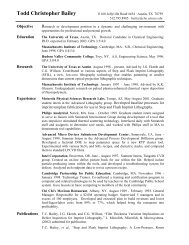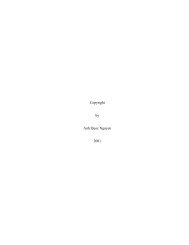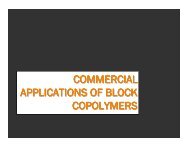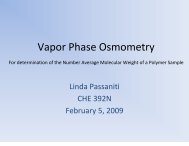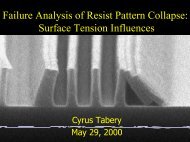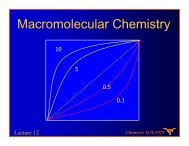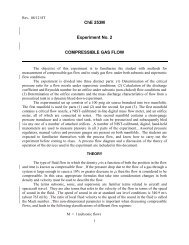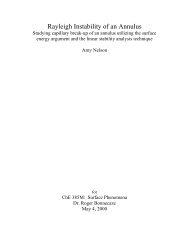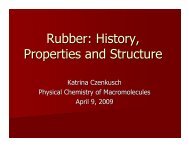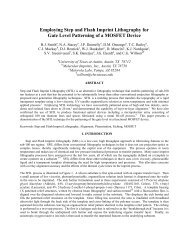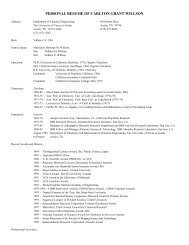Lecture 18
Lecture 18
Lecture 18
You also want an ePaper? Increase the reach of your titles
YUMPU automatically turns print PDFs into web optimized ePapers that Google loves.
Macromolecular Chemistry<br />
Mitsuo Sawamoto<br />
Joseph Kennedy<br />
+++Cationic Polymerization+++<br />
<strong>Lecture</strong> <strong>18</strong><br />
Chemistry 367L/392N
Classical Monomers for<br />
Cationic Polymerisation<br />
OR<br />
OR<br />
OR<br />
Chemistry 367L/392N
Initiation<br />
+<br />
E+<br />
+ CH 2 CR 2 ECH 2 CR 2<br />
Initiator mineral acid : H 2 SO 4 , H 3 PO 4<br />
lewis acid : AlCl 3 , BF 3 , TiCl 4 , SnCl 4<br />
Coinitiator<br />
BF 3 + H 2 O HOBF 3<br />
- H<br />
+<br />
AlCl 3 + RCl AlCl 4 - R +<br />
Chemistry 367L/392N
Rearrangement<br />
CH 3<br />
X + CH<br />
+ 3<br />
CH 2 CH CH<br />
XCH 2 CH CH<br />
H:shift<br />
CH 3<br />
CH 3<br />
XCH 2 CH 2 C + CH 3<br />
CH 3<br />
monomer<br />
CH 2 CH 2 C<br />
CH 3<br />
CH 3<br />
R R<br />
R + +<br />
+
Special case of β-elimination (E2)
A controversial claim made by Professor Sawamoto<br />
Sawamoto<br />
He successfully repeated the analog of the Szwarc<br />
experiment with vinylcabazole and HI. We will learn more<br />
about this from Rob Ono.
Living cationic polymerisation<br />
OR<br />
• using HI/I 2<br />
• shortly afterwards HI/ZnX 2 X= I, Br, Cl<br />
• M n ∝ [M]/[I]<br />
• Block copolymer by sequential addition<br />
• Mn increases linearly with conversion
Isomers of Polymers<br />
<br />
For example , polymer with structure<br />
unit -[ C 2 H 4 O-] n can be polyvinyl<br />
alcohol or polyethylene oxide<br />
[ CH2 CH ] n [ CH2 CH2 O ] n<br />
OH<br />
polyvinyl alcohol<br />
polyethylene oxide<br />
Chemistry 3<strong>18</strong>N
Natural Rubber (isomers matter)<br />
African Tree<br />
CH 2<br />
CH 3<br />
C<br />
C<br />
H<br />
CH 2<br />
Gutta Percha<br />
n<br />
harder<br />
CH 2<br />
CH 3<br />
C<br />
CH CH 2<br />
Isoprene<br />
South American tree<br />
CH 2 CH 2<br />
C C n<br />
CH 3 H<br />
Hevea<br />
softer<br />
Chemistry 3<strong>18</strong>N
Chemistry 3<strong>18</strong>N
Chicle (Manilkara zapota), native tree of Central America and the West Indies.<br />
Chemistry 3<strong>18</strong>N
Natural Rubber (isomers matter)<br />
African Tree<br />
CH 2<br />
CH 3<br />
C<br />
C<br />
H<br />
CH 2<br />
Gutta Percha<br />
n<br />
harder<br />
CH 2<br />
CH 3<br />
C<br />
CH CH 2<br />
Isoprene<br />
South American tree<br />
CH 2 CH 2<br />
C C n<br />
CH 3 H<br />
Hevea<br />
softer<br />
Chemistry 3<strong>18</strong>N
The synthetic rubber program<br />
How<br />
See web links for more history<br />
Chemistry 3<strong>18</strong>N
Polymer Macrostructure vs. Microstructure<br />
- Macrostructure: ‘what the whole molecule looks like’<br />
- Clearly, a huge influence on properties ---> viscosity, etc.<br />
- Microstructure: ‘how individual monomers or atoms are arranged’<br />
- One example: Alternating v. random copolymers…<br />
- Also: Stereochemical configurations<br />
Differences in microstructure can have a huge impact on polymer properties!<br />
Stereochemical configurations:<br />
-Polymerization of propylene…<br />
Same as…<br />
Stereogenic<br />
Center!<br />
CH 3<br />
CH 3<br />
n<br />
H<br />
n<br />
CH 3<br />
Conventional View<br />
There’s an H here, too…



